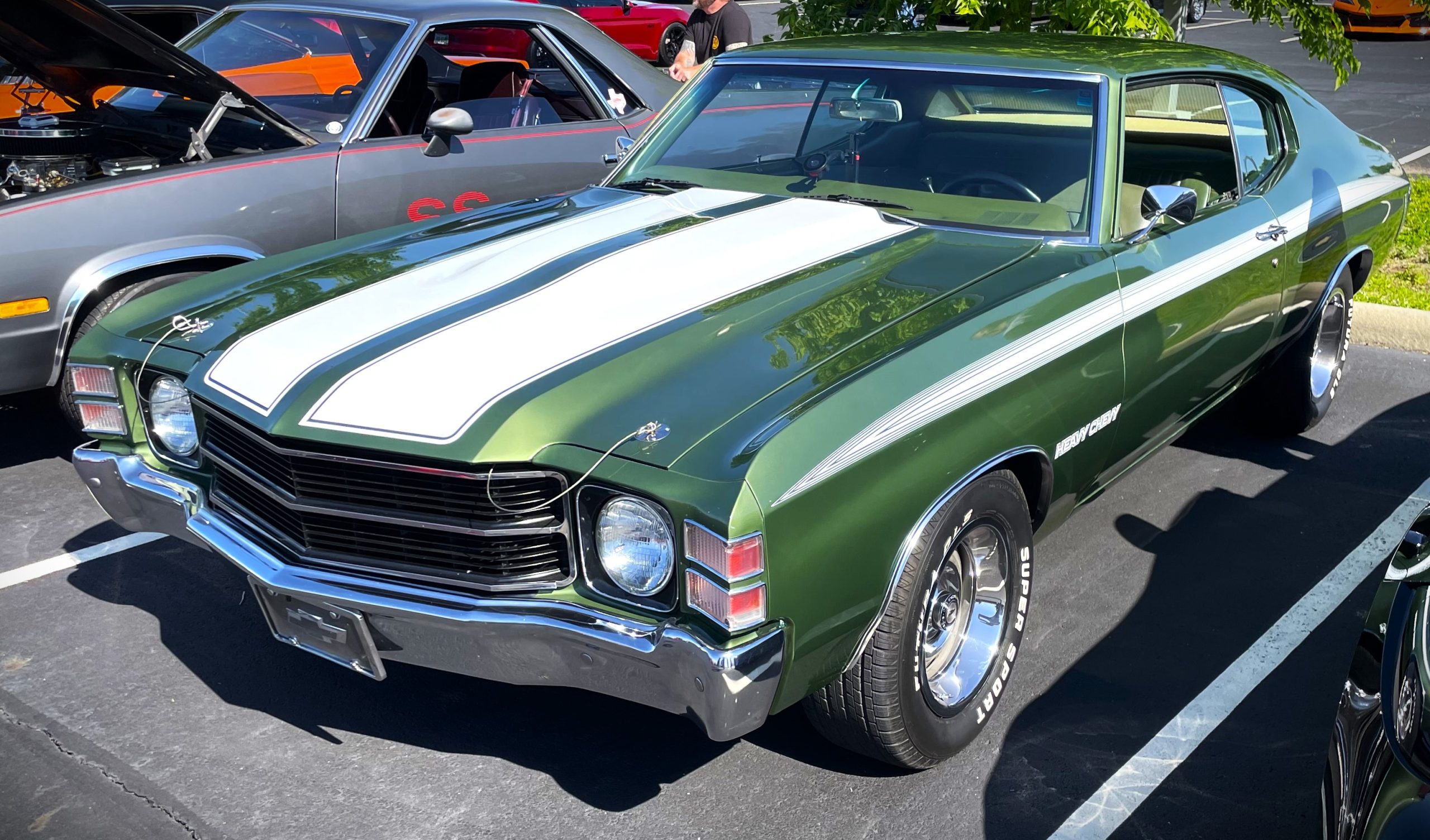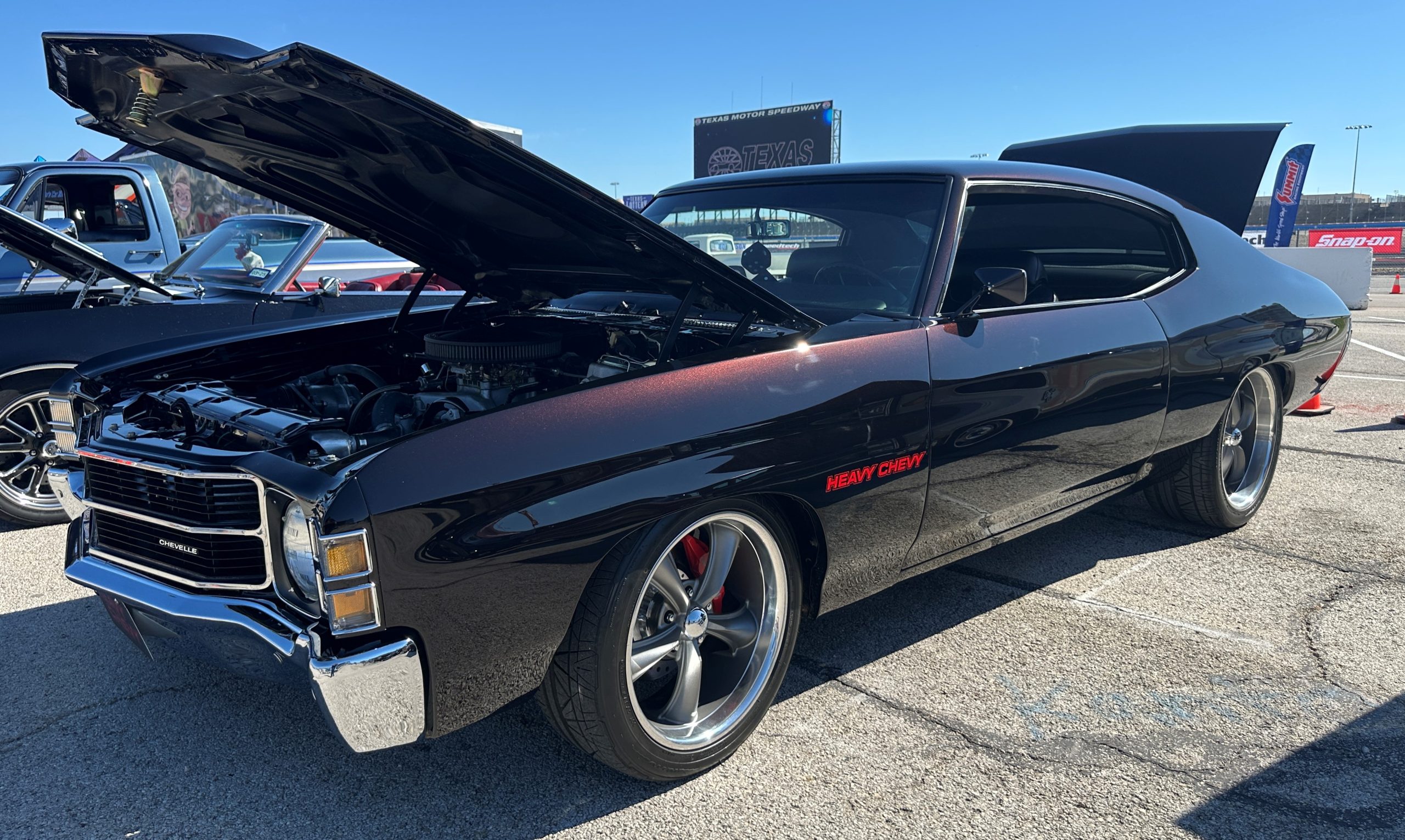Go to any classic car show across the United States, and it’s very likely that you’ll see at least one Chevrolet Chevelle. During a production run that spanned well over a decade, GM cranked out boatloads of Chevelle wagons, sedans, coupes, and convertibles.
***
Story Summary Overview
- Performance appearance package on Chevy Chevelle from 1971 to 1972
- Intended to fly under the insurance premium radar
- Go-fast looks, without go-fast price tag
- It could be optioned with Chevy small & big block V8 engines, except the 454
- Included hood pins, unique blacked-out grille & stripe package
***

But the Chevelle’s ubiquity also means we’re always discovering all sorts of new and interesting details about these cars. Case in point, this 1971 “Heavy Chevy” Chevelle we saw during the 2021 Hot Rod Power Tour.

What is a Heavy Chevy Chevelle?
Available in 1971 and 1972, the Heavy Chevy was a sub-model of the Chevrolet Chevelle that balanced musclecar looks with a budget-friendly price.
Why did it exist?
It’s no secret that the 1960s/70s musclecar market was dominated by “the youths.” And that’s why you saw advertising departments come up with all sorts of ideas to attract this coveted demographic. Mopar had its outlandish color palette and cartoon tie-ins. AMC had unique performance variants like SC/Rambler and The Machine.
And heck, Pontiac even called upon Paul Revere to tell folks about The Special Great One.

But perhaps the most important lure the automakers had for younger customers was price.
So, similar to what Pontiac had done with the GT-37, Chevy assembled an affordable performance package built on a stripper-spec base Chevelle.

For starters, checking the Heavy Chevy box on the build sheet got you some slick decals, accents, and rally wheels.
To back up its musclecar look, the Heavy Chevy was only offered with a V8. Even better, you could get most of the engines available on a regular Chevelle, ranging from the 307 up to the 402 LS3 big block. The only V8 off the table was the 454—which was reserved exclusively for the Chevelle SS.
More importantly, since the Heavy Chevy was spec’d off the base Chevelle, it often helped performance buyers sneak in under the radar of insurance companies and their rapidly rising insurance rates.

Examining This 1971 Heavy Chevy Chevelle
Unfortunately we couldn’t find the Chevelle’s owner to get details on this Heavy Chevy. We know it’s a 1971, thanks to its front grille and indicator lights. And it’s dang-near spotless, so it’s either incredibly original or received a quality restoration.

One of the first things you’ll notice about Heavy Chevy Chevelles is the stripe along the bodyline, very reminiscent of that aforementioned GTO Judge. Then check out the cool “Heavy Chevy” logos on the fenders and the leading edge of the hood.
This particular Heavy Chevy Chevelle also wears the optional vinyl roof, which has got to be rare, considering it undoubtedly added to the sticker price of an otherwise budget-oriented car.

Yet, there are some anomalies that may indicate this is a tribute car.
First off, it’s missing the blacked-out grille of a factory Heavy Chevy (though that may be simply because the original one couldn’t be restored). And while it’s got the signature bulging hood of the Heavy Chevy package, it’s missing the hood pins. Perhaps this one was pin-delete?

Regardless, it’s an awesome car and the Heavy Chevy Chevelle is proof that there’s always something new to discover at car shows. (It’s also a nice little reminder to always look closer at every vehicle you come across, because there may be a peculiar stripe, wheel, or badge that makes a classic ride that much more unique!)


Most of the Heavy Chevys I’ve run across had the 307 engine; the insurance industry was in full destruction mode by mid-71 when they came out. And likely, as it was back then, the majority produced were moderately equipped.
Hey that’s my car
Tell us more about it,why are the hoodpins missing,what happened to tge original grille?
Awesome Car, glad we got to see it on the tour!
I own 1. Bought new in August 1972. Rudolph Chevrolet in El Paso Texas. Still have it 49 yrs later.
My brother Scott owned the ’72. He didn’t put antifreeze in and during a hard freeze in Paris, Tx, the block cracked. He went to the bank and borrowed money on a new blueprinted long block with pop up pistons, cam, headers…It became one of the fastest cars in Paris around 1979. He was 3 years older than me & often people would tell me of his antics running from the law or drag racing thru town. He let me take it out on a double date once and the window broke in the back on a cold night. I was coming back into town from Pat Mayse lake and we were all freezing. I buried the needle and got pulled over slowing down coming into town at 88mph. Took my whole paycheck to pay the ticket. $57
It was yellow with black strips
Please share photos of the car. Thank you. My brother purchased a brand new Heavy Chevy just before he left for the US Navy. It was red with black stripes. I had forgotten what the lettering looked like. Thank you.
I remember the crimped hood and the hood pins. It had black vinyl seat covers. Very cool! So is it okay with collectors to do a restoration with up-to-date features like a/c, blue tooth, new motor, new seats, etc.? Or must it always be using only genuine rebuilt parts or original parts only?
That’s the best part of the automotive hobby: Rebuild the car the way you want it!
…
If you want to go with a chalk-mark restoration, go for it! If you want to drive the car a lot, then a modern engine, an upgraded retro-looking stereo and air conditioning retrofit are great ideas too.
…
Just have fun, learn new stuff, and make your project yours!
My neighbors bought a bronze HEAVY CHEVY new in 1972. They were Austrian and in their 70’s at that time. They always washed it on Saturdays, and would walk across the highway to the grocery store if it was raining. After they both passed in 1982, their neice offered it to my dad for $4,500. It had 6,000 miles on it. 35 years later I finally made peace with my father for not buying it for me (I was 14 at the time). Still see it occassionally around the area, and it still looks BEAUTIFUL!
The ’71 chevelle grills rarely survive from origial. If you used the factory equiptment bumper jack to change a flat, the bumper brackets or the bumper would twist into the grille and crack it at least. The green paint job does look darker than original
My Mom had one. It was orange with a black vinyl top. It had hood pins. It had a 350 engine but only 250 he. My mom drove it so slow, the muffler got plugged up and would not run. Cool car for a lady in her late 40’s.
[…] Heard of a “Heavy Chevy” Chevelle? Learn More About This Under-the-Radar Performance Package:https://www.onallcylinders.com/2021/10/06/ever-heard-of-a-heavy-chevy-chevelle-learn-more-about-this…Munster’s “Drag-U-La” On The Block At Mecum In January […]
I have a 1971 Heavy Chevy (green) that needs some love, my dad bought it to restore it but did not get to do it…. the woods grew up around it and one through the grill but I would love to find out the specs on this and the how toos for possibly restoring or selling it….. I have pictures too! Thank you, Tina
Hey Tina, thanks for reading.
…
Click here for an original Chevy sales brochure that may help–and the good news is that there is plenty of parts support for this particular model. Click here to see some restoration parts for the 1971 Chevy Chevelle.
Do you still have the car ? If you do I mite be interested!!!
Posting for a friend in Midway BC Canada. He has a 1972 Heavy Chevy he purchased in 1983, it was already a 350 stock eliminator car, he has since swapped in an L88 427 that ran Hi 10’s, and now has a 540 ci that runs mid 9’s and weighs less than 2800 lbs. Original yellow paint with black stripes, and will be running top comp at Thunder Mountain in Kelowna BC this summer. No way to post a pic here unfortunately, but it has the hood pins, black grill etc.
My first car was a used 71 Heavy Chevy 402 big block 3 speed. Mine was no frills with no a/c and only an am radio, bench seats and vinyl flooring. But mine was super quick from traffic light to traffic light. Metallic green with black strips sitting on Firestone wide ovals and 69 SS wheels. That car will always have a special place in my memories.
I have a rare 71, it has the 402 big block, with the M20 4 speed. It was my high school car in 1975…later sold it to get married and start a family. Wife divorced me 30 years later, went looking for it, and actually FOUND IT, in a farmers barn 40 miles from my house. All intact, and was fortunate enough to buy it back..True story!
Congrats buddy !
Awesome. I wish I could find my father’s 70 Chevelle.
i know a lady that has one lol 55 years strong one owner
I had just returned from Viet Nam in 1972 and was stationed at Ft. Huachuca AZ. I went to the Chevy dealer and saw a brand new white Heavy Chevy with black strips, hood pins, 350 ci engine, 3 speed in the floor transmission, vinyl floor mats, and the price was $3693.60. The dealer gave me an 8 track player and one 8 track tape! I bought it. The payments were 36 months, $102.60/month. I had it for 30 months and my then wife wrecked it, total loss, with 96,360 miles on it, the insurance paid it off and gave me a check for $30. How I wish I had it back. It was beautiful, and had a rated HP of 165 because it had a 4 bbl carb.
I had a 1971 gold color which was probably at the low end of the model run. It had no hood pins, cloth bench seats, no carpeting, and a 307 with an automatic transmission. It looked great from the outside but was your basic chevelle. The bench seat was a valuable asset back in the day.
Everyone knows about the heavy chevy,thete also was a heavy half pickup
I have a 1971 Heavy Chevy, Mulsanne blue (now white) with black interior. Bought it from the original family back here in Clayton County Iowa. It’s been used and abused but good driver. I tried to buy it when I was 17 yrs old. I’m now 63 and bought it 4 yrs ago during covid. It’s a work in progress. Was built in mid- March of 1971 in Kansas City. It’s not an original car but iIlove it.